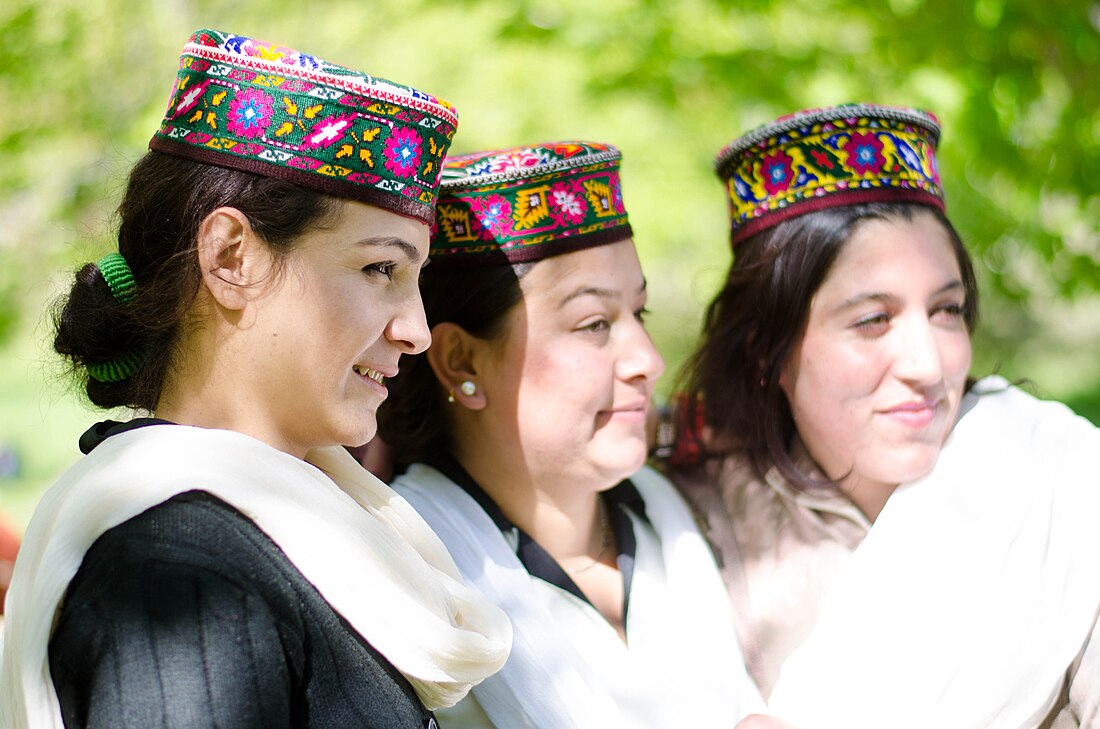Burusho people
Ethnolinguistic group of Kashmir, South Asia From Wikipedia, the free encyclopedia
The Burusho, or Brusho (Burushaski: بُرُشݸ, burúśu[6]), also known as the Botraj,[7][8] are an ethnolinguistic group indigenous to the Yasin, Hunza, Nagar, and other valleys of Gilgit–Baltistan in the northern part of Kashmir[9] with a tiny minority of around 350 Burusho people residing in Jammu and Kashmir, India.[8][10] Their language, Burushaski, has been classified as a language isolate.[11]
بُرُشݸ | |
|---|---|
 A group of Burusho women in the Hunza Valley | |
| Total population | |
| 126,300 (2018)[1] | |
| Languages | |
| Burushaski[2] | |
| Religion | |
| Ismaili Shia and Shia Islam[3][4][5] |
History
This section needs expansion. You can help by adding to it. (March 2020) |
Although their origins are unknown, it is claimed that the Burusho people "were indigenous to northwestern India and were pushed higher into the mountains by the movements of the Indo-Aryans, who traveled southward sometime around 1800 B.C."[4]
Prior to the modern era, the area in which most Burusho now live was part of the princely state of Hunza under the British Raj, until becoming part of Pakistan.[12]
Culture
The Burusho are known for their rich music and dance culture, along with progressive views towards education and women.[13]
Longevity myth
Medical researchers believe that peace, harmony and less exposure to stress in the lives of the Hunza people is linked to their longer life spans. The lack of urban harms, the healthy way of life, moderate use of fruits and vegetables and other factors contribute to the health and long life of this people.[14]
Independent writers have refuted these longevity myths,[15] citing a life expectancy of 53 years for men and 52 for women, although with a high standard deviation.[16]
Jammu and Kashmir
Summarize
Perspective
A group of 350 Burusho people also reside in the Indian union territory of Jammu and Kashmir, being mainly concentrated in Batamalu, as well as in Botraj Mohalla, which is southeast of Hari Parbat.[8] This Burusho community is descended from two former princes of the British Indian princely states of Hunza and Nagar, who with their families, migrated to this region in the 19th century A.D.[8] They are known as the Botraj by other ethnic groups in the state,[8] and practice Shiite Islam.[17] Arranged marriages are customary.[18]
Since the partition of India in 1947, the Indian Burusho community have not been in contact with the Pakistani Burusho.[19] The Government of India has granted the Burusho community Scheduled Tribe status, as well as reservation, and therefore, "most members of the community are in government jobs."[8][17] The Burusho people of India speak Burushashki, also known as Khajuna, and their dialect, known as Jammu & Kashmir Burushashski (JKB), "has undergone several changes which make it systematically different from other dialects of Burushaski spoken in Pakistan".[17] In addition, many Jammu & Kashmiri Burusho are multilingual, also speaking Kashmiri and Hindustani, as well as Balti and Shina to a lesser extent.[17]
Genetics
Summarize
Perspective
A variety of Y-DNA haplogroups are seen among certain random samples of people in Hunza. Some haplogroups found in the Burusho were R1a1 and R2a, the former of which is associated with Indo-European peoples and the Bronze Age migration into South Asia c. 2000 BC, and probably originated in either South Asia,[20][21] [22][23][24][25] Central Asia[26][27] or Iran and the Caucasus.[28][29] R2a, unlike its extremely rare parent R2, R1a1 and other clades of haplogroup R, is now virtually restricted to South Asia. Two other typically South Asian lineages, haplogroup H1 and haplogroup L3 (defined by SNP mutation M20) have also been observed from few samples.[30][27]
Other Y-DNA haplogroups reaching considerable frequencies among the Burusho are haplogroup J2, associated with the spread of agriculture in, and from, the Neolithic Near East,[26][27] and haplogroup C3, of East Eurasian male origin and possibly representing the patrilineage of Genghis Khan. Present at lower frequency are haplogroups O3, also of East Eurasian male lineage, and Q Siberian male origin, P, F, and G.[27] DNA research groups the male ancestry of some of the Hunza inhabitants with speakers of Pamir languages and other mountain communities of various ethnicities, due primarily to the M124 marker (defining Y-DNA haplogroup R2a), which is present at high frequency in these populations.[31] However, they have also an East Asian genetic contribution, suggesting that at least some of their ancestry originates north of the Himalayas.[32] No Greek genetic component among the Burusho have been detected in tests.[33][34]
Influence in the Western world
Summarize
Perspective
Healthy living advocate J. I. Rodale wrote a book called The Healthy Hunzas in 1948 that asserted that the Hunzas, noted for their longevity and many centenarians, were long-lived because they consumed healthy organic foods, such as dried apricots and almonds, and had plenty of fresh air and exercise.[35] He often mentioned them in his Prevention magazine as exemplary of the benefits of leading a healthy lifestyle.
Dr. John Clark stayed among the Hunza people for 20 months and in his 1956 book Hunza - Lost Kingdom of the Himalayas[36] writes: "I wish also to express my regrets to those travelers whose impressions have been contradicted by my experience. On my first trip through Hunza, I acquired almost all the misconceptions they did: The Healthy Hunzas, the Democratic Court, The Land Where There Are No Poor, and the rest—and only long-continued living in Hunza revealed the actual situations". Regarding the misconception about Hunza people's health, Clark also writes that most of his patients had malaria, dysentery, worms, trachoma, and other health conditions easily diagnosed and quickly treated. In his first two trips he treated 5,684 patients.
The October 1953 issue of National Geographic had an article on the Hunza River Valley that inspired Carl Barks' story Tralla La.[37]
See also
Citations
General and cited references
External links
Wikiwand - on
Seamless Wikipedia browsing. On steroids.
